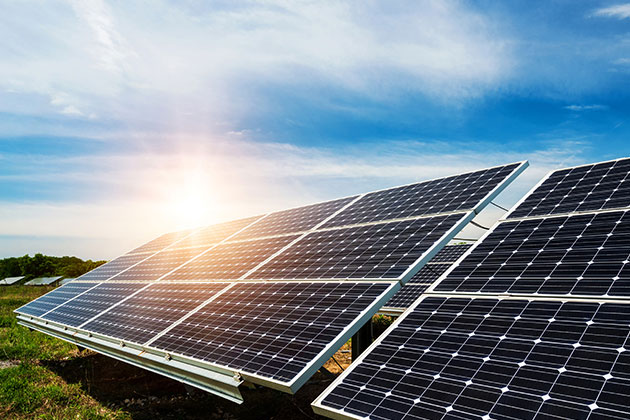Study describes a novel all-perovskite tandem nishati ya jua cell which has the potential to provide inexpensive and more efficient way to harness Sun’s energy to generate electrical power
Utegemezi wetu kwenye chanzo kisichoweza kurejeshwa cha nishati inayoitwa nishati ya kisukuku kama vile makaa ya mawe, mafuta, gesi imekuwa na athari mbaya kwa wanadamu na mazingira. Uchomaji wa nishati ya mafuta huongeza athari ya chafu na husababisha ongezeko la joto duniani, huharibu makazi, husababisha hewa, maji na uchafuzi wa ardhi na huathiri afya ya umma. Kuna hitaji la haraka la kujenga teknolojia endelevu ambayo inaweza kusaidia nguvu dunia kwa kutumia nishati safi. Nguvu ya jua technology is one such method which has the capability to harness Sun’s light – the most abundant renewable source of energy – and convert it into electrical energy or power. The advantageous factors of nishati ya jua energy in terms of benefitting humans and environment have played a key role in promoting use of nishati ya jua nishati.
Silicon ni nyenzo ya kawaida kutumika kutengeneza nishati ya jua seli ndani solpaneler that are available in the market today. The photovoltaic process of nishati ya jua cells can transform sunlight into electricity without additional use of any fuel. Design and efficiency of silicon nishati ya jua panels has significantly improved over decades due to advancements in manufacturing and technology. The photovoltaic efficiency of a nishati ya jua cell is defined as the portion of the energy which is in the form of sunlight and which can be converted into electricity. Photovoltaic efficiency and overall costs are the two main limiting factors in nishati ya jua panels today.
Apart from silicon nishati ya jua cells, tandem nishati ya jua cells are also available in which specific cells are used which are optimized for every section of the Sun’s spectrum thereby leading to increase in overall efficiency. A material called perovskites is considered better than silicon in absorbing high-energy blue photons from sunlight i.e. another part of the Sun’s spectrum. Perovskites are polycrystalline material (generally methylammonium lead trihalide (CH3NH3PbX3, where X is iodine, bromine or chlorine atom). Perovskites are easy to process into sunlight-absorbing layers. Earlier studies have combined silicon and perovskites into solar cells i.e. having silicon cells on the top which can absorb yellow, red and near infrared photons along with perovskite cells thus almost doubling the production of power.
Katika utafiti mpya uliochapishwa katika Bilim on May 3 researchers have for the first time developed all perovskites tandem solar cells which give efficiency of up to 25 percent. This material is called lead-tin mixed low-band gap perovskite film ((FASnI3)0.6 MAPbI3)0.4; FA for formamidinium and MA for methylammonium). Tin has the disadvantage of reacting with oxygen from air creating defects in the crystalline lattice which can disrupt movement of electrical charge in the nishati ya jua cell thereby limiting cell’s efficiency. Researchers found a way to prevent tin in perovskite from reacting with oxygen. They used a chemical compound called guanidinium thiocyanate to significantly improve structural and optoelectronic properties of lead-tin mixed low-band gap perovskite films. The compound guanidinium thiocyanate coats perovskite crystallites in the nishati ya jua absorbing film thus preventing oxygen from going inside to react with tin. This straightaway enhances efficiency of the solar cell from 18 to 20 percent. Also, when this new material was combined with conventionally used high-absorbing top perovskite layer, the efficiency further increased to 25 percent.
Utafiti wa sasa unaelezea kwa mara ya kwanza muundo wa seli za jua za sanjari kwa kutumia filamu zote nyembamba za perovskite na teknolojia hii siku moja inaweza kuchukua nafasi ya silicon kwenye seli za jua. Nyenzo mpya ni ya ubora wa juu, ni ya bei nafuu na utengenezaji wake ni rahisi wakati gharama ni ya chini ikilinganishwa na seli za silicon na silicon-perovskites sanjari. Perovskites ni nyenzo zilizoundwa na mwanadamu ikilinganishwa na silicon na paneli za jua zenye msingi wa perovskites ni rahisi kunyumbulika, nyepesi, na uwazi nusu. Ingawa nyenzo za sasa zitachukua muda kuzidi ufanisi wa teknolojia ya silicon-perovskite. Hata hivyo, filamu za polycrystalline zenye msingi wa perovskite zina uwezo wa kubuni seli za sanjari za jua ambazo zinaweza kutoa ufanisi wa hadi asilimia 30 huku zikiweka mambo mengine bila kuzuiwa. Tafiti zaidi zinahitajika ili kufanya nyenzo ziwe thabiti, ziwe thabiti zaidi na ziweze kutumika tena ili kupunguza athari kwa mazingira. Sekta ya nishati ya jua ni mojawapo ya inayokua kwa kasi na lengo kuu ni kugundua njia mbadala ya nishati safi.
***
{Unaweza kusoma karatasi asili ya utafiti kwa kubofya kiungo cha DOI kilichotolewa hapa chini katika orodha ya (vyanzo) vilivyotajwa}
Chanzo (s)
Tong J. et al. Muda wa maisha wa mtoa huduma wa 2019 wa > μs 1 katika perovskites za Sn-Pb huwezesha seli za jua zenye ufanisi zaidi za perovskite tandem sanjari. Sayansi, 364 (6439). https://doi.org/10.1126/science.aav7911






































